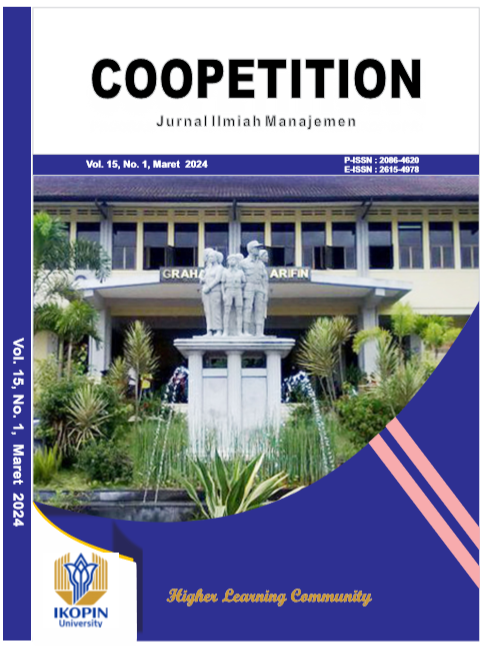Pengaruh Karakterisik Bank Terhadap Capital Adequacy Ratio
DOI:
https://doi.org/10.32670/coopetition.v15i1.4231Keywords:
Return on Assets, Liquidity, Net Performing Loans, Capital Adequacy Ratio.Abstract
Capital adequacy is an important part of a company's financial performance, because achieving an optimal capital adequacy ratio (CAR) indicates that the company has sufficient capital to fund each of its operations. Sufficient capital allows the company to easily innovate, so that it can develop the company's productivity. Interestingly, CAR is influenced by various factors, so it is necessary to study academically the factors that influence CAR. The purpose of this study is to determine the factors that influence CAR. This study uses a quantitative approach with empirical methods using Bank BTN data for the 2010-2020 period. The results show that this model contributes 81% to changes in CAR, partially showing that ROA has a negative effect on CAR, meaning that the lower the ROA, the higher the CAR, LDR has a negative effect on CAR, meaning that the lower the LDR, the higher the CAR, and the NPL has an effect negative to CAR means that the lower the NPL, the higher the CAR. This indicates that increases or decreases in ROA, LDR, and NPL have an impact on changes in CAR at Bank BTN.
Downloads
References
Admati, A. R., & Hellwig, M. F. (2013). Does debt discipline bankers? An academic myth about bank indebtedness. Rock Center for Corporate Governance at Stanford University Working Paper, (132).
Africano, F. (2016). Pengaruh NPF terhadap CAR serta Dampaknya terhadap Profitabilitas Bank Umum Syariah di Indonesia. Jurnal Ilmiah STIE MDP, 6(1).
Allen, F., & Santomero, A. M. (1998). The Theory of Financial Intermediation. Journl of Banking & Finance, 21, 1461–1485.
Almilia & Herdiningtyas, W. (2005). Analisis Rasio CAMEL terhadap Prediksi Kondisi Bermasalah pada Lembaga Perbankan Periode 2000-2002. Jurnal akuntansi dan Keuangan, 7(2).
Anggono, A. H. (2014). Determinants of capital adequacy ratio (CAR) in 19 commercial banks (Case Study: Period 2008–2013). Journal of Business and Management, 3(7), 752-764.
Anjani, D. A., & Purnawati, N. K. (2014). Pengaruh Non Performing Loan (NPL), Likuiditas dan Rentabilitas Terhadap Rasio Kecukupan Modal (Udayana University).
Barus, A. C. (2016). Analisis Faktor-Faktor yang Mempengaruhi non performing loan pada bank Umum di Indonesia. Jurnal Wira Ekonomi Mikroskil, 6(2), 113-122.
Bikker, J. A., Wesseling, S., & Els, P. J. A. (2003). Intermediation, integration and internationalisation: a survey on banking in Europe. De Nederlandsche Bank.
Bukian, N. M. W. P., & Sudiartha, G. M. (2016). Pengaruh Kualitas Aset, Likuiditas, Rentabilitas dan Efisiensi Operasional terhadap Rasio Kecukupan Modal. E-Jurnal Manajemen Unud, 5(2), 1189-1221.
Diamond, D. W., & Rajan, R. G. (2001). Liquidity Risk, Liquidity Creation, and Financial Fragility: A Theory of Banking. Journal of Political Economy, 109(2), 287–327. Retrieved from http://www.journals.uchicago.edu/doi/10.1086/319552
Dolapcioglu, S., & Doğanay, A. (2022). Development of critical thinking in mathematics classes via authentic learning: an action research. International Journal of Mathematical Education in Science and Technology, 53(6), 1363-1386.
Duttweiler, R. (2009). Managing Liquidity in Banks : A Top Down Approach. West Sussex, UK: John Wiley & Sons, Ltd.
Elsa, E., Utami, W., & Nugroho, L. (2018). A Comparison of Sharia Banks and Conventional Banks in Terms of Efficiency, Asset Quality and Stability in Indonesia for the Period 2008-2016. International Journal of Commerce and Finance, 4(1), 134-149.
Greuning, H. Van, & Bratanovic, S. B. (2009). Analyzing Banking Risk : A Framework for Assessing Corporate Governance and Risk Management (3rd editio). Washington DC, United States of America: The World Bank.
Hidayat, W. W. (2022). CAMEL Ratio on Profitability Banking performance: Case Studies of Banks in Indonesia. Atestasi: Jurnal Ilmiah Akuntansi, 5(2), 456-468.
Kuncoro, M. & Suhardjono, (2012). Manajemen Perbankan: Teori dan Aplikasi, Edisi Kedua, Fakultas Ekonomi dan Bisnis UGM.
Lukman, D. (2009). Manajemen Perbankan. Jakarta: Ghalia Indonesia.
Mei, C. A. I., & Huang, Z. (2014). Analysis of Non Performing Loan and Capital Adequacy Ratio among Chinese Banks in The Post-Reform Period in China. Journal of Advanced Studies in Finance (De Gruyter Open), 5(2).
Moh'd Al-Tamimi, K. A., & Obeidat, S. F. (2013). Determinants of capital adequacy in commercial banks of Jordan an empirical study. International Journal of Academic research in Economics and management sciences, 2(4), 44.
Neuberger, D. (1998). Industrial Organization of Banking : A Review. International Journal of The Economics of Business, 5(1), 97–118.
Pravasanti, Y. A. (2018). Pengaruh NPF dan FDR Terhadap CAR dan Dampaknya Terhadap ROA Pada Perbankan Syariah Di Indonesia. Jurnal Ilmiah Ekonomi Islam, 4(03), 148-159.
Putri, N. P. S. W., & Dana, I. M. (2018). Pengaruh NPL, likuiditas, dan rentabilitas terhadap CAR pada BPR konvensional skala nasional di Indonesia. E-Jurnal Manajemen Unud, 7(4), 1862-1891.
Riyadi, S. (2006). Banking Assets and Liability Management. Jakarta: Lembaga Penerbit FE UI.
Sagner, J. (2014). Working capital management: applications and case studies. John Wiley & Sons.
Scholtens, B., & Van Wensveen, D. (2003). The theory of financial intermediation: an essay on what it does (not) explain (No. 2003/1). SUERF Studies.
Shingjergji, A. (2013). The Impact of Macroeconomic Variables on the Non Performing Loans in the Albanian Banking System During 2005-2012. Academic Journal of Interdisciplinary Studies, 2(9), 335.
Soenjoto, W. P. P. (2018). Analisa Manajemen Dana Bank Syariah Dalam Konsep Pemasaran Konvensional. Jurnal Istiqro, 4(1), 1-17.
Soliha, E. & Taswan, (2002). Pengaruh Kebijakan Hutang Terhadap Nilai Perusahaan Serta Beberapa Faktor Yang Mempengaruhinya. Jurnal Bisnis dan Ekonomi, 9(2), 149-163.
Syahrir, A. A. (2012). Analisis Pengaruh LDR, NPL, dan CAR terhadap Resiko Likui-ditas pada Bank Pembangunan Daerah (BPD) Se-Indonesia Tahun 2007-2011. Fakultas Ekonomi dan Bisnis Universitas Hasanuddin Makassar.
Yuwono, W., & Sudaryono, E. (2010). Analisis Capital, Asset Quality, Earning, dan Liquidity Sebagai Alat Untuk Memprediksi Kinerja Keuangan Bank Perkreditan Rakyat. Jurnal Bisnis dan Manajemen, 10(1), 81-90.
Downloads
Published
How to Cite
Issue
Section
License
Copyright (c) 2024 Coopetition : Jurnal Ilmiah Manajemen

This work is licensed under a Creative Commons Attribution 4.0 International License.


















